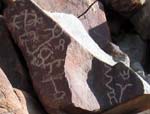Corn Springs Petroglyphs 

 If
you haven't been to Corn Springs, you are missing a real treat. Here
is a spot where you can visit a real desert oasis complete
with palm trees, drive right up to some great petroglyphs,
enjoy solitude and beautiful scenery, explore a funky cabin/museum
and top it all off with a well maintained BLM campground! So
load up the kids and pets! This won't require any hardcore
jeeping; you can easily do this trip in the family sedan. Just
don't do it in the summer! We were there in November
and the temperatures were quite comfortable.
If
you haven't been to Corn Springs, you are missing a real treat. Here
is a spot where you can visit a real desert oasis complete
with palm trees, drive right up to some great petroglyphs,
enjoy solitude and beautiful scenery, explore a funky cabin/museum
and top it all off with a well maintained BLM campground! So
load up the kids and pets! This won't require any hardcore
jeeping; you can easily do this trip in the family sedan. Just
don't do it in the summer! We were there in November
and the temperatures were quite comfortable.To
access this site head out Interstate 10 to the Corn Springs
exit, just east of the Desert Center exit. Turn south
off the freeway onto a frontage road and go a half mile or
so east to the well signed Corn Springs Road. Take this
road southwesterly for about seven miles. The road is
dirt, but is well graded and maintained. As you near
Corn Springs you will enter a canyon and head west up the wash. The
palm trees in the distance mark the location of Corn Springs
and the campground. However, just before you arrive,
be on the lookout for the petroglyphs on the north side of
the road. A little exploring and boulder scrambling is
needed to get the best views. Also, be sure to cross
the wash and check out the rocks directly to the south. Some
of the more elaborate panels are found here. David Whitley,
in his book A
Guide to Rock Art Sites: Southern California
and Southern Nevada,  estimates
that the petroglyphs here date from the last few thousand years,
with many probably made in the last 1,000 years. The
permanent spring here provided life giving water for a prehistoric
Indian settlement on the major east-west trail connecting the
Colorado River and what is now the Coachella Valley. The
petroglyphs here probably represent a shaman's portrayal of
the spirits encountered during a vision quest.
estimates
that the petroglyphs here date from the last few thousand years,
with many probably made in the last 1,000 years. The
permanent spring here provided life giving water for a prehistoric
Indian settlement on the major east-west trail connecting the
Colorado River and what is now the Coachella Valley. The
petroglyphs here probably represent a shaman's portrayal of
the spirits encountered during a vision quest.
 estimates
that the petroglyphs here date from the last few thousand years,
with many probably made in the last 1,000 years. The
permanent spring here provided life giving water for a prehistoric
Indian settlement on the major east-west trail connecting the
Colorado River and what is now the Coachella Valley. The
petroglyphs here probably represent a shaman's portrayal of
the spirits encountered during a vision quest.
estimates
that the petroglyphs here date from the last few thousand years,
with many probably made in the last 1,000 years. The
permanent spring here provided life giving water for a prehistoric
Indian settlement on the major east-west trail connecting the
Colorado River and what is now the Coachella Valley. The
petroglyphs here probably represent a shaman's portrayal of
the spirits encountered during a vision quest.After
the petroglyphs, if you will be camping, you might want to
get a spot at the campground. Limited water is available,
but each site has a table and many have shade ramadas. The
restroom facilities were quite clean when we were there. We
had expected to see numerous campers, but the facility was
completely empty. I understand that it can fill up quickly,
though. It makes for a great base camp to hike into the
adjacent mountains and canyons. Big Horn sheep frequent
the area, and there is quite a bit of bird life and lots of
other critters.
 Be
sure to explore the road as it continues west out of the campground. You
can't miss the Little Chad Mill site. The cabin is a
typical desert affair --- quaint and funky! Dilapidated
furniture, flapping screens and broken windows can't mar the
charm of the impromptu "museum." Wander around. Go
on in and look at the memorabilia. By all means leave
an entry in the log book. And be sure to walk over to
the edge of the wash by the water tank/arrastre. If
you look down you will see what I think might have been a well
with some type of Rube Goldberg contraption that did
who knows what!
Be
sure to explore the road as it continues west out of the campground. You
can't miss the Little Chad Mill site. The cabin is a
typical desert affair --- quaint and funky! Dilapidated
furniture, flapping screens and broken windows can't mar the
charm of the impromptu "museum." Wander around. Go
on in and look at the memorabilia. By all means leave
an entry in the log book. And be sure to walk over to
the edge of the wash by the water tank/arrastre. If
you look down you will see what I think might have been a well
with some type of Rube Goldberg contraption that did
who knows what! We
really enjoyed our day here. It was peaceful and full
of the echoes of an earlier time. We would have stayed
longer, but a long hike into the Palen-McCoy
Wilderness Area and the McCoy
Spring petroglyphs awaited us tomorrow. Click
below for some visuals of Corn Springs.
